Cisco CleanAir’s Legacy
Available Languages
Bias-Free Language
The documentation set for this product strives to use bias-free language. For the purposes of this documentation set, bias-free is defined as language that does not imply discrimination based on age, disability, gender, racial identity, ethnic identity, sexual orientation, socioeconomic status, and intersectionality. Exceptions may be present in the documentation due to language that is hardcoded in the user interfaces of the product software, language used based on RFP documentation, or language that is used by a referenced third-party product. Learn more about how Cisco is using Inclusive Language.
When Cisco CleanAir® was first released, it launched a revolution in the Wi-Fi industry and a campaign to get non-Wi-Fi interference out of corporate Wi-Fi coverage. For those who don’t remember, it was a nightmare. Bluetooth had no idea that it interfered with Wi-Fi, and almost every “wireless” controller or consumer gadget was created using some sort of wireless technology in the 2.4-GHz range.
Legacy CleanAir’s core hardware technology was purpose-built to analyze and positively identify individual non-Wi-Fi devices. It could do this even in a room full of like device types (a feat unmatched in the industry to this day). Because of its precision, CleanAir provides the data source for multiple services. It will identify non-Wi-Fi interference sources by type (Bluetooth, microwave oven, etc.) and locate them accurately on a map. It can measure the impact and provide a severity mapped overlay of the actual impact area, instantly allowing the user to identify the likely impact and location of interference sources. With Cisco leading the industry’s awareness of the realities of RF interference, manufacturers of consumer devices began to design around Wi-Fi, and today we peacefully coexist with most of the non-Wi-Fi consumer gear found in the 5-GHz spectrum. CleanAir as an enterprise-grade tool embedded in Cisco® access points was first released in 2010. For CleanAir this required careful analysis of the RF attributes that were characterized against patterns of known RF energy. Today this is known in the AI/ML world as “classification based on feature values”; however, CleanAir’s capabilities predated the practical AI/ML of today.
In April 2020, the U.S. Federal Communications Commission released the largest grant of spectrum ever for Wi-Fi, providing a big boon to Wi-Fi’s current congested space. There is no free (unused) spectrum in the United States or any other major regulatory region in the world. So when a band is redesignated, this often comes with conditions designed to protect any incumbent licensed users of the band who are still relying on it. For 6 GHz, this amounts to several use cases that are still active today, such as satellite uplinks and microwave repeaters for TV broadcasts and remote locations, as well as some government uses. Incumbent users must be protected, so a primary concern in writing the regulations was to prevent Wi-Fi from interfering with these existing users. There are no protections for Wi-Fi, however, and some of these incumbent use cases clustered within the UNII6 and UNII8 bands have more than enough power to interfere with low power (indoor) (LPI) operations. 6 GHz provides an immense opportunity for Wi-Fi technology to continue to provide value around the world, and with 180% more spectrum to cover and a whole new class of sources of potential RF interference to keep track of, it was time to take CleanAir to the next level.
CleanAir Pro is a fully reimagined solution built from the ground up to solve the present and foreseeable future challenges impacting the Wi-Fi industry today. Our amassed data lake of high-resolution and accurate spectrum data consists of tens of millions of samples of non-Wi-Fi signal sources, from straight constant carrier to advanced Frequency-Hopping Spread Spectrum (FHSS), Time-Division Multiple Access (TDMA), and other common sources of interference.
The objectives in creating CleanAir Pro were to:
● Create a sustainable and easily adaptable solution that can create its own classifiers through Machine Learning (ML), relying on CleanAir’s vast knowledge base.
● Envision the future, and as 6 GHz continues to evolve around the world, meet the challenges that inevitably come with occupying new spectrum with incumbent technologies.
● Maintain the legacy CleanAir protection by preserving the core values that made CleanAir indispensable. For this it must:
◦ Be able to accurately detect and identify common non-Wi-Fi sources of interference.
◦ Quantify negative Wi-Fi performance impact on Wi-Fi traffic within the cell.
◦ Merge concurrent instances detected by multiple access points into a single device alert.
◦ Identify and immediately mitigate catastrophic interference events.
◦ Provide non-Wi-Fi spectrum data to be used by Cisco’s Radio Resource Management (RRM) and AI-Enhanced RRM algorithms to better manage coexistence between competing technologies.
● Be able to quickly and continuously adapt to new interference sources and adapt through machine learning to scale with the future.
CleanAir Pro supports (in Cisco IOS XE 17.13)
● Device classification in 2.4, 5, and 6 GHz, created through Cisco AI/ML analytics.
● Providing 2.4-, 5-, and 6-GHz spectrum spectrograms and classification details to Cisco DNA Center, Assurance Intelligent Capture spectrum dashboards.
● Merging of multiple same device reports (proprietary and patented) into a single alert that can be located on a floor plan to assist in remediating the offending signal.
● Persistent Device Avoidance (2.4 and 5 GHz only) to augment RRM’s knowledge of non-Wi-Fi devices and their requirements/ impact, allowing better coexistence of multiple technology environments.
● Event-Driven RRM (ED-RRM) for sources of interference in all three bands (2.4, 5, and 6 GHz). The ED-RRM feature immediately identifies and recovers the access point in clear spectrum to maintain operational efficiency. RRM subsequently marks and monitors the event to avoid it entirely on all access points within range until it can be mitigated (within 30 seconds, depending on the severity).
● AirQuality and the individual Severity metrics that bring clarity as to which device’s radio is the root cause.
In addition to supporting legacy CleanAir, other current features rely on the scanning power of the CleanAir Pro core hardware to provide a hitless experience for Wi-Fi users.
● Wireless Intrusion Detection and prevention (WIDS/WIPS), rogue detection, and containment.
● All RRM off-channel transmit and receive requirements.
● FastLocate.
How does CleanAir Pro do this?
Given the expanded coverage requirements, raw radio power is the first step. CleanAir Pro shares monitor resources with other out-of-band monitored services (RRM, FastLocate, adaptive WIDS/WIPS). Now, with 6 GHz, CleanAir Pro commands 30% of total dwell time. CleanAir Pro radios listen to 160 MHz per dwell and rely on an optimized sampling interval to help ensure that each of the supported services receives the dwell time required. Dynamic shifts in focus and number of dwells are used to respond to different priorities. All told, the software and hardware that make up today’s CleanAir Pro are worthy of the CleanAir legacy.
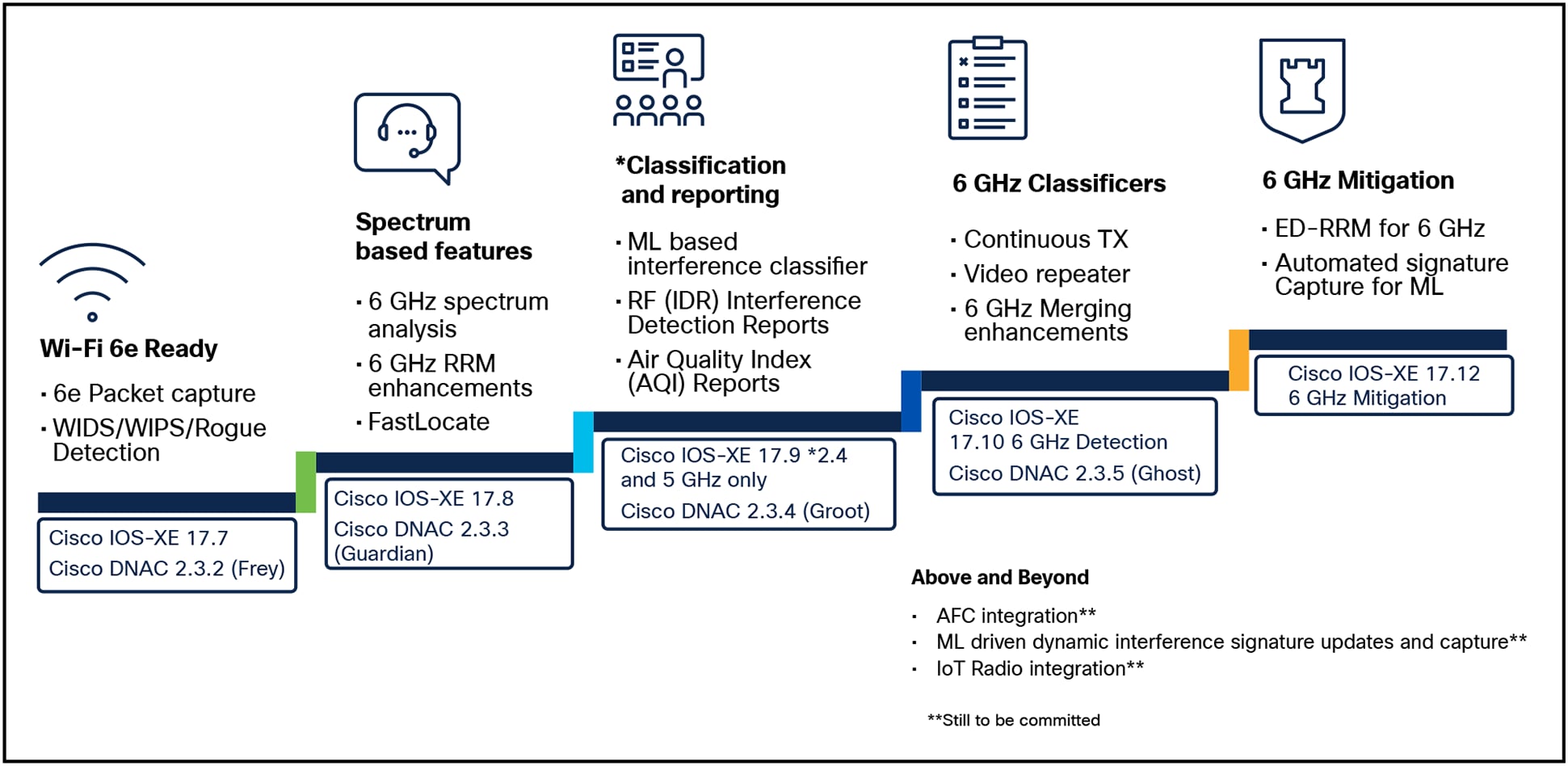
CleanAir Pro release timelines
What are the CleanAir Pro features and benefits?
Merging
A key differentiator is CleanAir Pro’s ability to positively identify individual devices. Without this, each access point that is able to identify the device will send an individual Interference Device Report (IDR). At enterprise densities, a Bluetooth signal can be observed by tens of access points simultaneously, with no ability to determine if each is a different device or the same device is actually being detected at multiple points. CleanAir Pro’s merging algorithms consolidate multiple reports into a single system-level report. Figure 2 contains a view of the wireless controller console showing the interference sources detected by access point. The cluster ID shows members of the same merged “cluster” of detections.
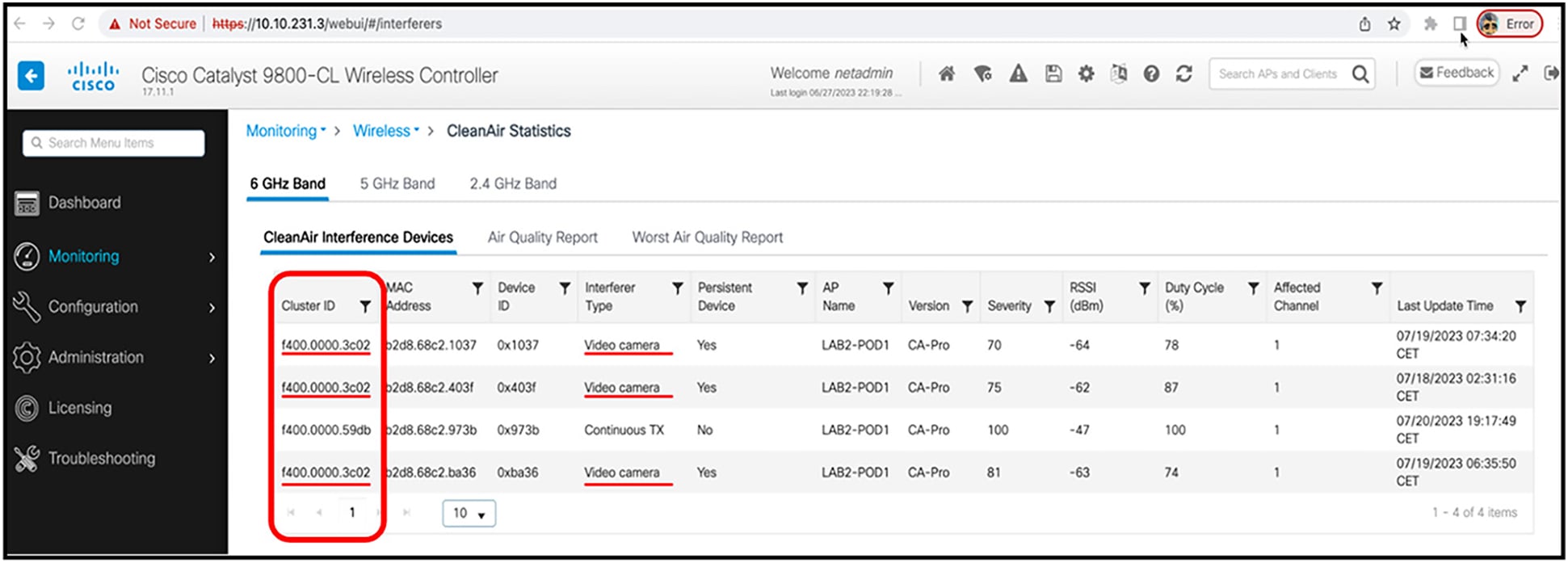
The CleanAir Pro cluster ID denotes devices that are part of the same cluster
A cluster ID is stored with the detection data and provides a clear view of the detection. You can access this information from the command line and display the Cluster Center to see the access point that is closest to the device location based on Received Signal Strength Indication (RSSI) and a list of the IDs of the other detecting access points.
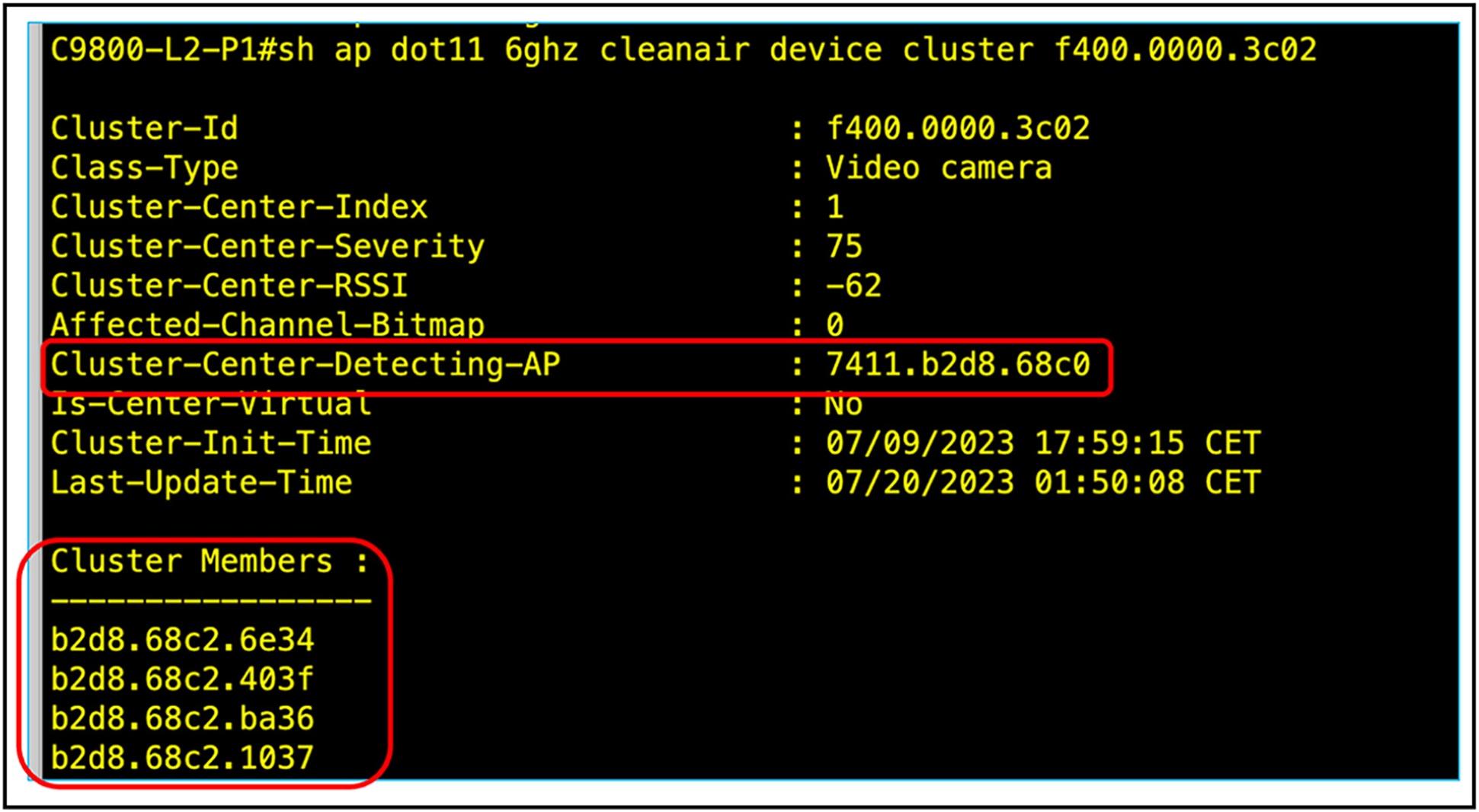
Command-line output of CleanAir Pro cluster ID contents
Without this merging process, each access point’s detection will produce an individual device entry, and there will be no way to determine if the problem is multiple devices or a single device being detected by many access points. If more than one access point is detecting the same device, the output is simply that device and no count of the number. The RSSI value will show the value for the access point that reported it last, so it will go up and down as detecting reports change between access points. The output is the same as the Spectrum Intelligence released by some of the legacy non CleanAir access points in the past.
Severity metric
Severity provides an estimate of the airtime that would be lost in a loaded cell with this device present. It is based on the device type and known interactions with Wi-Fi. Its RSSI as seen and duty cycle are also part of the equation. The busier and closer a device is to the access point, the higher the severity. Severity is represented as 1% to 100%, with 100% being a total blockage of the cell.
Non CleanAir Pro systems cannot produce a severity metric. With no ability to identify individual devices, there is no way to evaluate each against the detecting access point. Spectrum Intelligence does not produce a Severity metric.
AirQuality Index (AQ and AQI)
AirQuality (AQ) represents the concurrent negative impact all the devices within the access point’s cell are experiencing based on the accumulated discovered devices and their individual interference Severity metrics. The AirQuality Index (AQI) is represented as a value from 100% to 1%, with higher values being better. For example, suppose that an access point reports five individual Bluetooth devices, each with a Severity value of 2%. With AQI beginning at 100%, 5 devices x 2% would equal 10%. We subtract 10% from the initial 100% good AQI and the result is an AQI of 90%. The reporting access point’s cell has an AQI of 90%, indicating some impact but not a severe one.
Without CleanAir Pro, there is no Severity per device and no ability to locate a device relative to its surrounding cells, meaning there is no value to isolate to arrive at a total AQI for an access point’s cell. Spectrum Intelligence access points do not produce an AQI.
Event-Driven RRM
Non-Wi-Fi interference impacts Wi-Fi in different ways. First, by being active above Wi-Fi’s Clear Channel Assessment (CCA) threshold, it prevents Wi-Fi from accessing the channel and transmitting. If severe enough, it can block every device that can hear it from using Wi-Fi. ED-RRM is a safety valve for the most severely impacted cells, allowing the access point to immediately (within 30 seconds) change channels and not wait for a DCA cycle.
(The RRM default interval is 10 minutes, but it can be set to hours.) ED-RRM operates based on the AQI for a given access point or band. The trigger sensitivity can be set to:
● High sensitivity: AQI = 60%
● Medium sensitivity: AQI = 50%
● Low sensitivity: AQI = 31% (the default and recommended best practice)
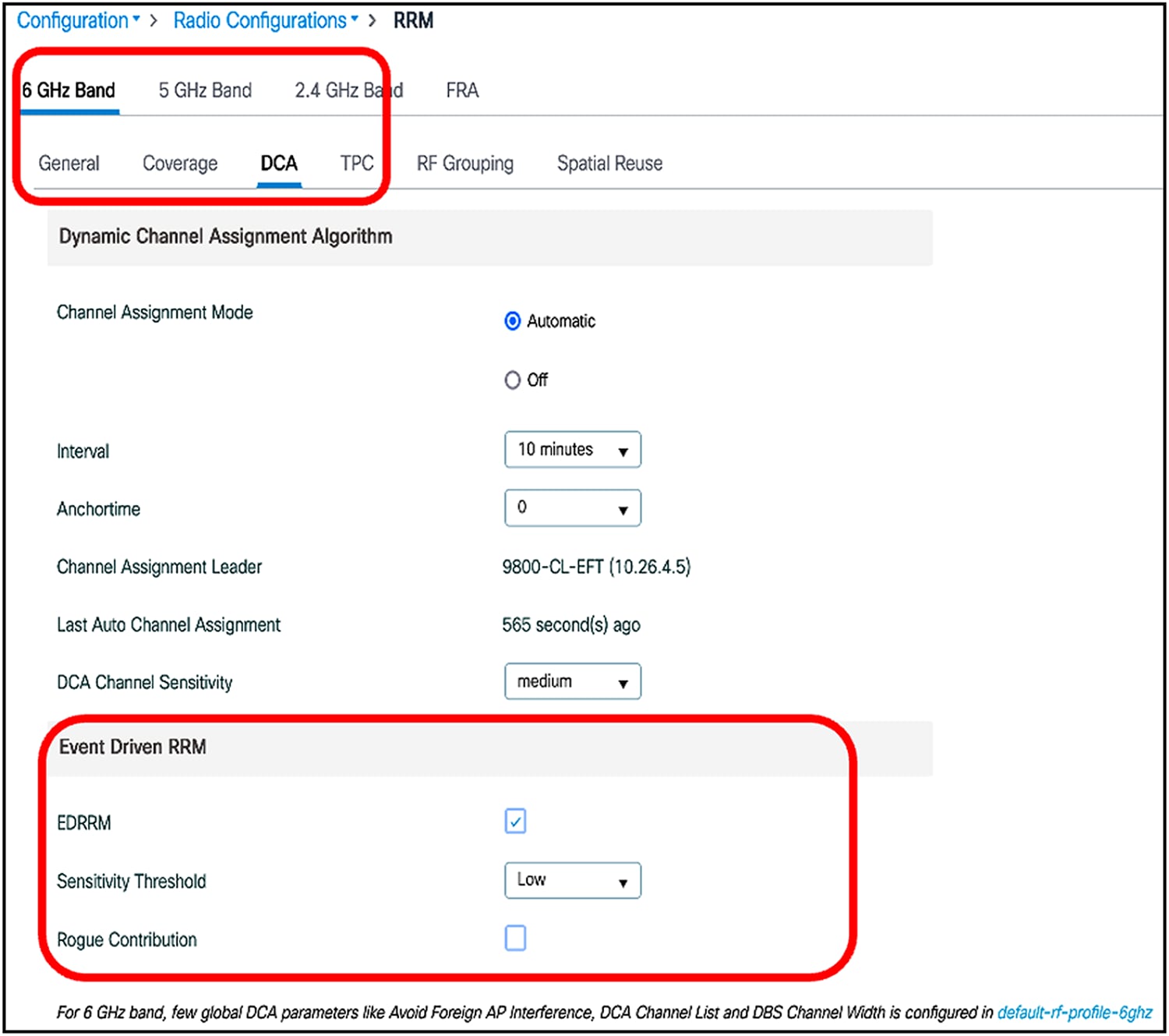
ED-RRM configuration for 6 GHz (Cisco IOS XE 17.13.1)
CleanAir Pro has supported ED-RRM in the 2.4- and 5-GHz bands since its release. As of Cisco IOS XE Release 17.13, it is supported on 6-GHz spectrum as well.
Visualizing CleanAir Pro data
CleanAir Pro is fully integrated with Cisco DNA Center Assurance as part of the Intelligent Capture suite of tools under Intelligent Capture spectrum.
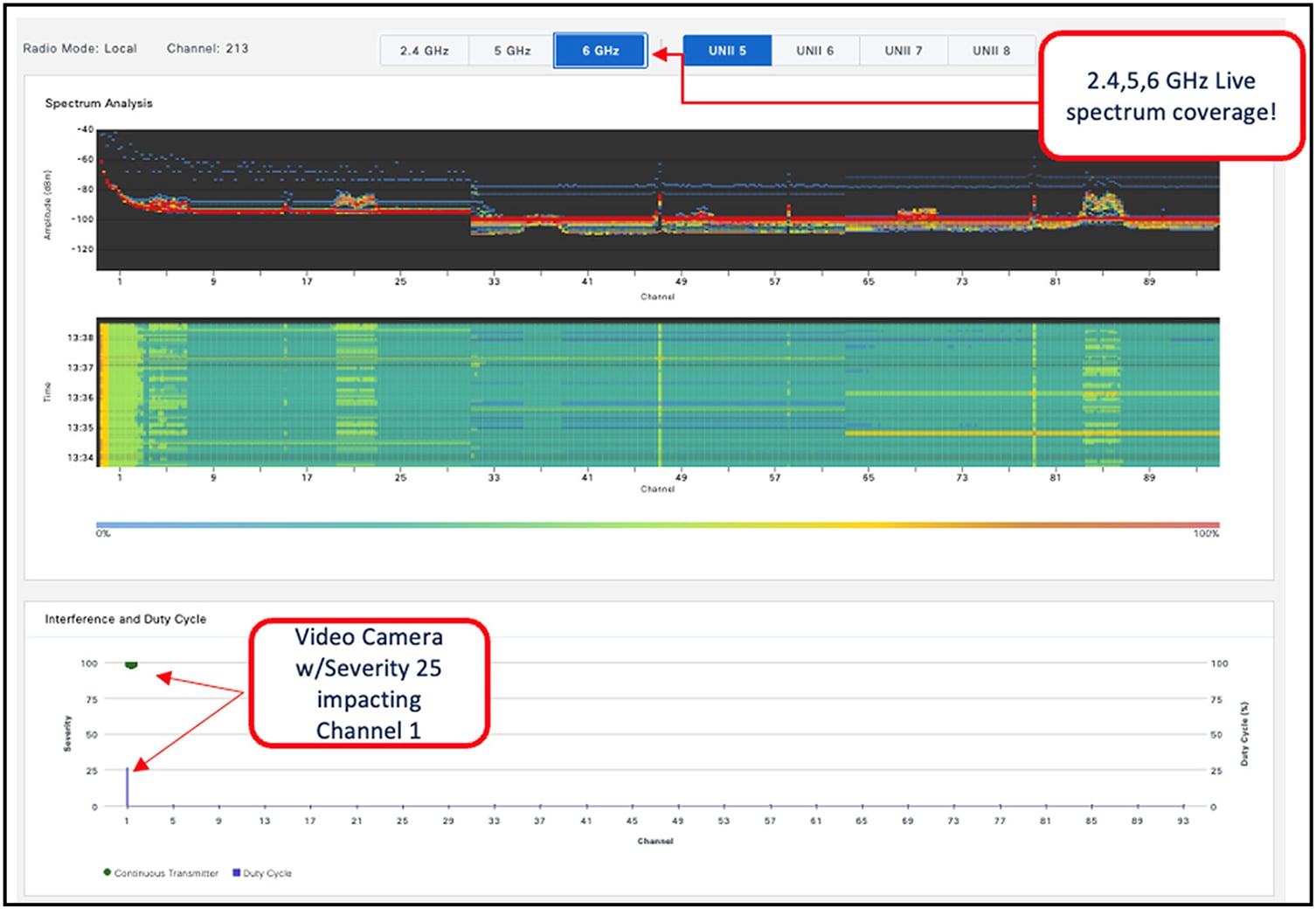
CleanAir Pro data is also visible on the Cisco Catalyst™ 9800 Series Wireless Controllers. You can view it on the main dashboard on the landing page.

You can drill down from the main dashboard or navigate to Monitoring/Wireless/CleanAir Statistics and see the individual detections per access point and more.

In Monitoring, select the device in the table to reveal its AQI and RSSI data in chart form.
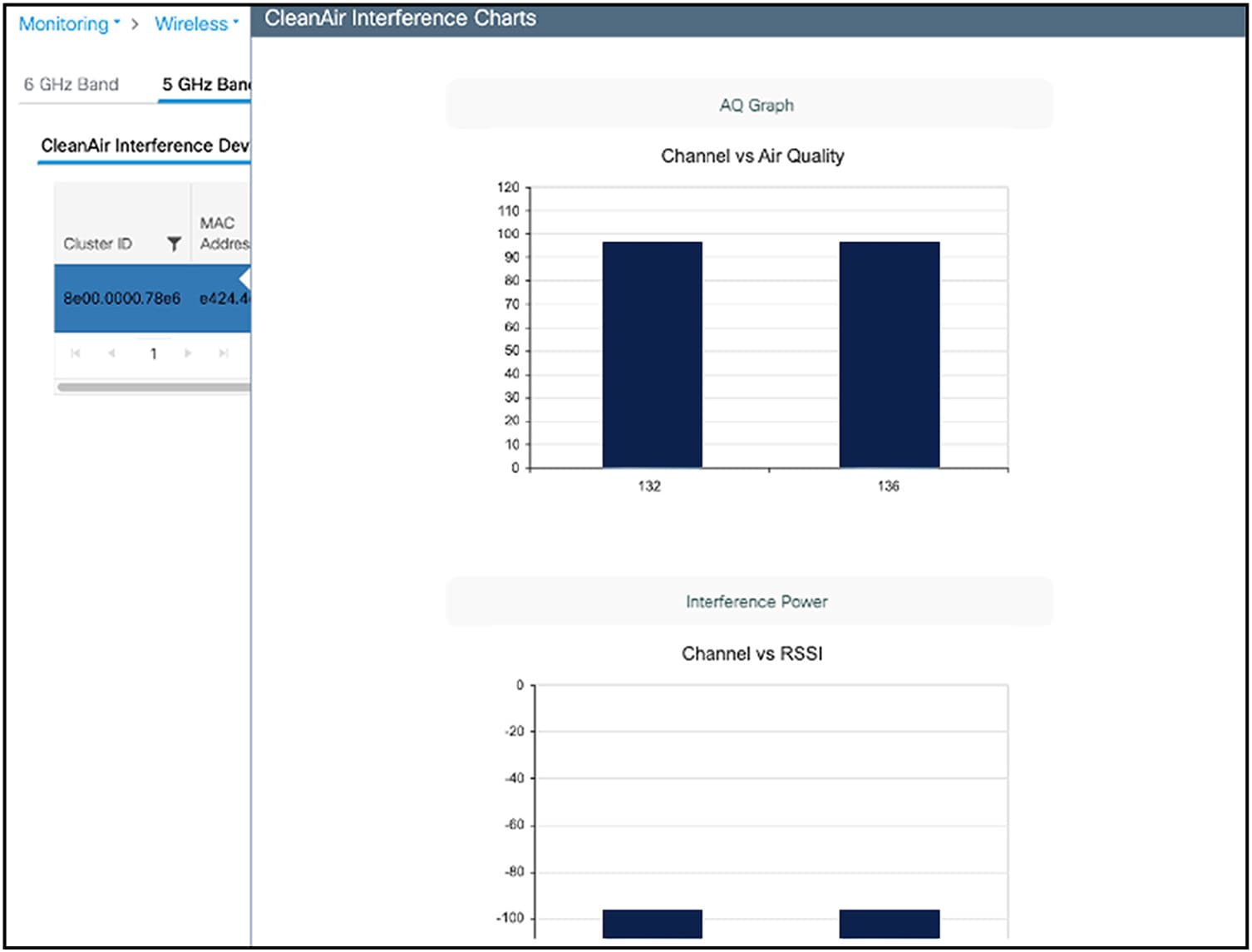
CleanAir has been a staple of Cisco’s wireless excellence since 2010. Cisco led the industry in identifying and drawing attention to the impact consumer and professional wireless devices were having on Wi-Fi networks. Over the years, the industry has evolved, and as a result of this leadership, devices that rely on wireless communications have learned to be polite around Wi-Fi – or better yet, to use Wi-Fi.
The addition of 6-GHz spectrum in 2020 for Wi-Fi operations is allowing Wi-Fi to expand its economic benefits and take advantage of the amazing capabilities being offered today and in the future. This new spectrum also provided an opportunity to revisit Cisco CleanAir and reimagine it in context with current and evolving challenges.
Today’s CleanAir pro is every bit as capable and effective as legacy Cisco CleanAir. CleanAir Pro is ready to meet the current and future challenges that await in spectrum. Having been redesigned from the ground up, Cisco CleanAir Pro uses ML from our vast data lake of signals to create the interferer signatures used in operation. CleanAir Pro was designed from the ground up to automate interference discovery, with classification for devices in the wild now, but also automation of new device classifications in the future.
CleanAir Pro will continue to lead the industry in discovering and providing actionable, in-context information to help operators make the critical decisions their networks demand 24 hours per day.